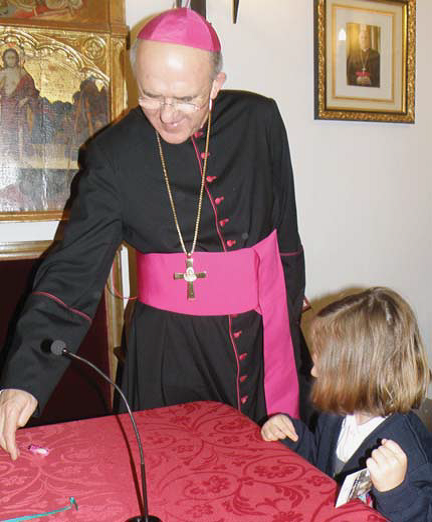Saint Therese of the Child Jesus
of the Holy Face
"God Made the Violet, Too: A Life of Leonie, Sister of St. Therese" can now be read online

You can read Fr. Albert Dolan's biography of Leonie Martin, God Made the Violet, Too: A Life of Leonie, Sister of St. Therese (Chicago: Carmelite Press, 1948) online thanks to HathiTrust Digital Library. Fr. Albert Dolan, who founded the Society of the Little Flower, visited France and became acquainted with the sisters of St. Therese; he then spoke and wrote about them in the United States as he spread devotion to St. Therese. You may read the account of his visits with the sisters of St. Therese in his book The Intimate Life of Saint Therese Portrayed by Those Who Knew Her.
"St. Therese of Lisieux and Nonviolence," by guest blogger Brother Joseph Schmidt, FSC
When we think about loving something or someone we rarely think of nonviolence. And certainly there is more to authentic love than nonviolence. But one moment of thought will help us to know that the basic element of love is, in fact, nonviolence.
When we speak, for example, of loving a person, we may think of good feelings and of intimacy and sharing. When we speak of loving a thing, for example ice cream, or a vacation spot, or a sports team, we may think also of good feelings. But what is most in common in the use of the word “love” to describe our relationship with people and things is what we do not feel toward them. We do not feel adversarial or hostile.
There is certainly more to love than nonviolence, but the common and basic element in our many uses of the word love is our sense of nonviolence toward what we say we love.
Nonviolence is the bottom line in our loving.
This helps us to understand what Jesus means when he says “love your enemy.” He is clearly not suggesting that we like our enemy, because if we felt “like” toward the person we experience as the enemy we would not have an “enemy” in the first place. By cultivating feeling of hostility we “make” and keep the enemy.
If, for whatever reason, we have feelings of dislike for a person and thereby make that person our “enemy,” Jesus is asking that we abide that negative feeling, not cultivate hostility, and thereby give love a chance. We give love a chance by simply not being violent toward the “enemy.”
I think this is the way Therese understood “loving the enemy.” Meditating on Jesus’ words she wrote: “We don’t have any enemies in Carmel.” But then she quickly qualified her statement, adding the insight: “but there are feelings.” The feelings that “there are,” and that Therese did have, were feelings of dislike and repugnance. She bore these feelings with as much patience as she could, did not cultivate these feelings into hostility and violence, and in that way came to “love the enemy.” She gives examples of this in the stories in the final section of Story of a Soul, as she describes her nonviolent relationships with the difficult sisters she lived with.
Therese clearly liked some sisters and disliked others, but she loved them all. The sisters she disliked were her “enemies;” but she “loved” them by building her relationship with them on a spirit of nonviolence toward herself and toward them.
Therese’s spirituality has no violence in it. It is the spirituality that we need personally and institutionally in these days of such subtle and overt violence.
"Joan of Arc: heart of fire, soul of a warrior," a play based on texts by St. Therese of Lisieux, presented as a sound and light show at the Basilica at Lisieux, May 9-10, 2013

On Thursday, May 9 and Friday, May 10, 2013, the Association "The Message of Therese," together with the management of the Shrine of Lisieux, presented a sound and light show, "Joan of Arc: heart of fire, soul of a warrior" at the Basilica of Lisieux.
The core of the show is a stage play, performed by professional actors and amateurs, made up of extracts from Therese's writing about Joan of Arc. Behind the actors, a giant screen shows the scenery and evokes a host of elements that fit into Joan's story. The soundtrack plays poignant music. Between the scenes written by Therese, which the actors play, videos told the transitional history, evoking the historical context of the life of Joan of Arc. This carefully researched work has been produced in collaboration with the Centre Jeanne d'Arc of the city of Orleans. Therese's text has been embedded in a broader framework.
The show was presented over two special days at Lisieux as part of a spiritual and cultural program on the theme of Therese of Lisieux and Joan of Arc, including Masses, conferences, and a concert. The planners hoped to attract 5,000 people to Lisieux for this event. A parallel exhibit about Therese and Joan of Arc is being presented at the Centre John Paul II, next to the Basilica. The exhibit will remain open until October 30, 2013.
This show was organized by the Association "The Message of Therese." Chaired by the Rector of the Shrine at Lisieux, it aims to organize various events to make the writings of Therese known in an artistic way. It has hundreds of volunteers who support the organization in different areas.
Therese wrote and starred in two plays, or "pious recreations," as they were then called in Carmel, about Joan of Arc. You may read them in The Plays of St. Therese of Lisieux: Pious Recreations, ed. Steven Payne, O.C.D. Washington, D.C.: ICS Publications, 2008.
Do you want to contribute to the process for the canonization of Blessed Louis and Zelie Martin, the parents of St. Therese of Lisieux?

Blessed Louis and Zelie Martin, the parents of St. Therese of Lisieux, are closer to being canonized than ever before. The Pilgrimage Office at the Shrine of Lisieux has announced that on Tuesday, May 21, 2013, the diocesan process in Valencia, Spain to examine whether the healing of a little girl named Carmen is a miracle attributed to the intercession of the Martin spouses will hold its closing ceremony. Then the file will be sent to Rome for a final decision in the matter of their canonization.
As the tribunal finishes its work, a work of the faithful begins. Guiding a cause from beatification to canonization is very expensive: in this case, trips to Spain, fees to medical specialists, costs for accommodation, duplicating and printing transcripts, and other costs. The Cause of the Martin spouses is asking the friends of Blessed Louis and Zelie Martin for the necessary support, and Mgr. Lagoutte, Rector of the Basilica at Lisieux, has launched an appeal for that purpose. We have translated into English the brochure with details; please view and download it here. See the home page of the appeal (which is in French). Please feel free to print and circulate the brochure; to circulate the link to it (http://tinyurl.com/bpqg9qe); and to e-mail it or post it on your own page.
Louis and Zelie supported many charitable and religious activities generously, and Louis wrote "Give, go on giving, and make people happy." Please prayerfully consider making a gift to their cause. And please continue to pray that the Holy Spirit enlightens the Church in this matter. Thank you.
Rejoice! The cause of St. Therese's parents is going to Rome. On May 21, 2013 the diocesan tribunal will finish examining the "presumed miracle" for Blessed Louis and Zelie Martin
 Mgr Carlos Osoro Serra, Archbishop of Valencia, with the little CarmenThe diocesan process to examine whether the healing of a child named Carmen whose parents asked Blessed Louis and Zelie Martin to intercede with God to obtain her cure should be considered as the miracle necessary to canonize them opened in Valencia, Spain on January 7, 2013. Its final session began in April, and I am happy to announce that the diocesan tribunal is about to complete its work. The official closing session will take place on Tuesday, May 21, 2013 in Valencia.
Mgr Carlos Osoro Serra, Archbishop of Valencia, with the little CarmenThe diocesan process to examine whether the healing of a child named Carmen whose parents asked Blessed Louis and Zelie Martin to intercede with God to obtain her cure should be considered as the miracle necessary to canonize them opened in Valencia, Spain on January 7, 2013. Its final session began in April, and I am happy to announce that the diocesan tribunal is about to complete its work. The official closing session will take place on Tuesday, May 21, 2013 in Valencia.
The closing of the diocesan tribunal to consider the "presumed miracle" brings to an end many years of work in France to examine the causes of the Martin spouses. You may read a detailed summary of the history of the cause in A Call to a Deeper Love: The Family Correspondence of the Parents of Saint Therese of the Child Jesus (tr. Ann Hess, ed. Dr. Frances Renda. New York: Alba House, 2011). Louis's cause was opened on March 22, 1957 in Lisieux, and Zelie's on October 10, 1957 in the diocese of Sees, where she died. Later the two causes were joined, and on March 26, 1994, Pope John Paul II declared that Louis and Zelie Martin had practiced "heroic virtue" and designated them "Venerable." After the examination of the healing of newborn Pietro Schiliro, they were beatified on October 19, 2008. A second miracle is necessary to open the way for their canonization.
 Mgr Jacques Habert, bishop of SeesMgr Carlos Osoro Serra, Archbishop of Valencia, will preside at the closing session. Mgr Jacques Habert, bishop of Sees, and Mgr Jean-Claude Boulanger,
Mgr Jacques Habert, bishop of SeesMgr Carlos Osoro Serra, Archbishop of Valencia, will preside at the closing session. Mgr Jacques Habert, bishop of Sees, and Mgr Jean-Claude Boulanger,  Mgr Jean-Claude Boulanger, bishop of Bayeux and Lisieuxbishop of Bayeux and Lisieux, will travel to Valencia for the closing ceremony. The next day the file will be submitted to the Congregation for the Causes of Saints in Rome, where it will be examined first by seven medical specialists, then by theologians, and finally by cardinals before it is given to the Holy Father. Although evidence is gathered and evaluated first at the diocesan level, the decision to canonize is always made by Rome.
Mgr Jean-Claude Boulanger, bishop of Bayeux and Lisieuxbishop of Bayeux and Lisieux, will travel to Valencia for the closing ceremony. The next day the file will be submitted to the Congregation for the Causes of Saints in Rome, where it will be examined first by seven medical specialists, then by theologians, and finally by cardinals before it is given to the Holy Father. Although evidence is gathered and evaluated first at the diocesan level, the decision to canonize is always made by Rome.
Please pray that the Church receives the light of the Holy Spirit to see whether God intends this couple to be canonized.